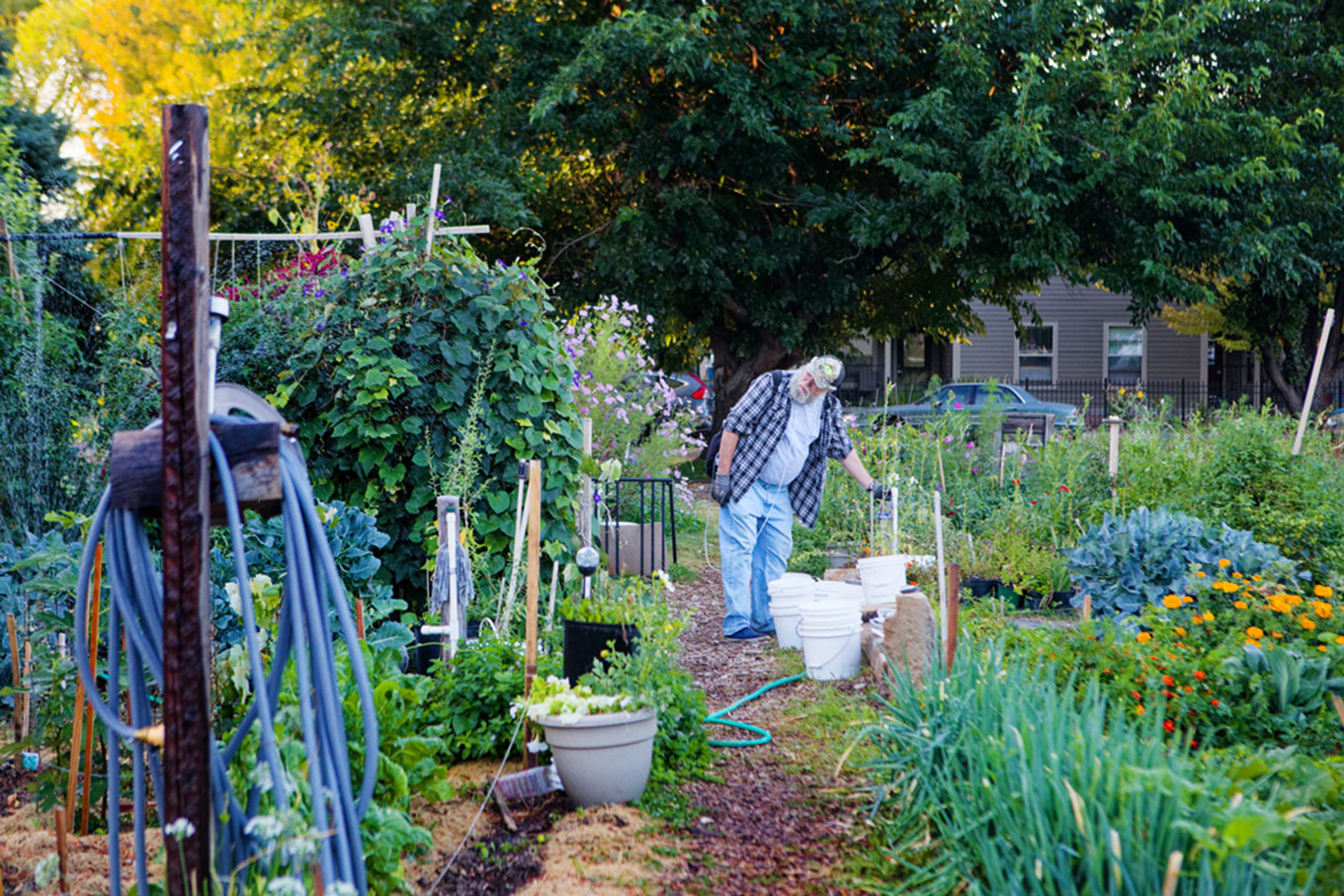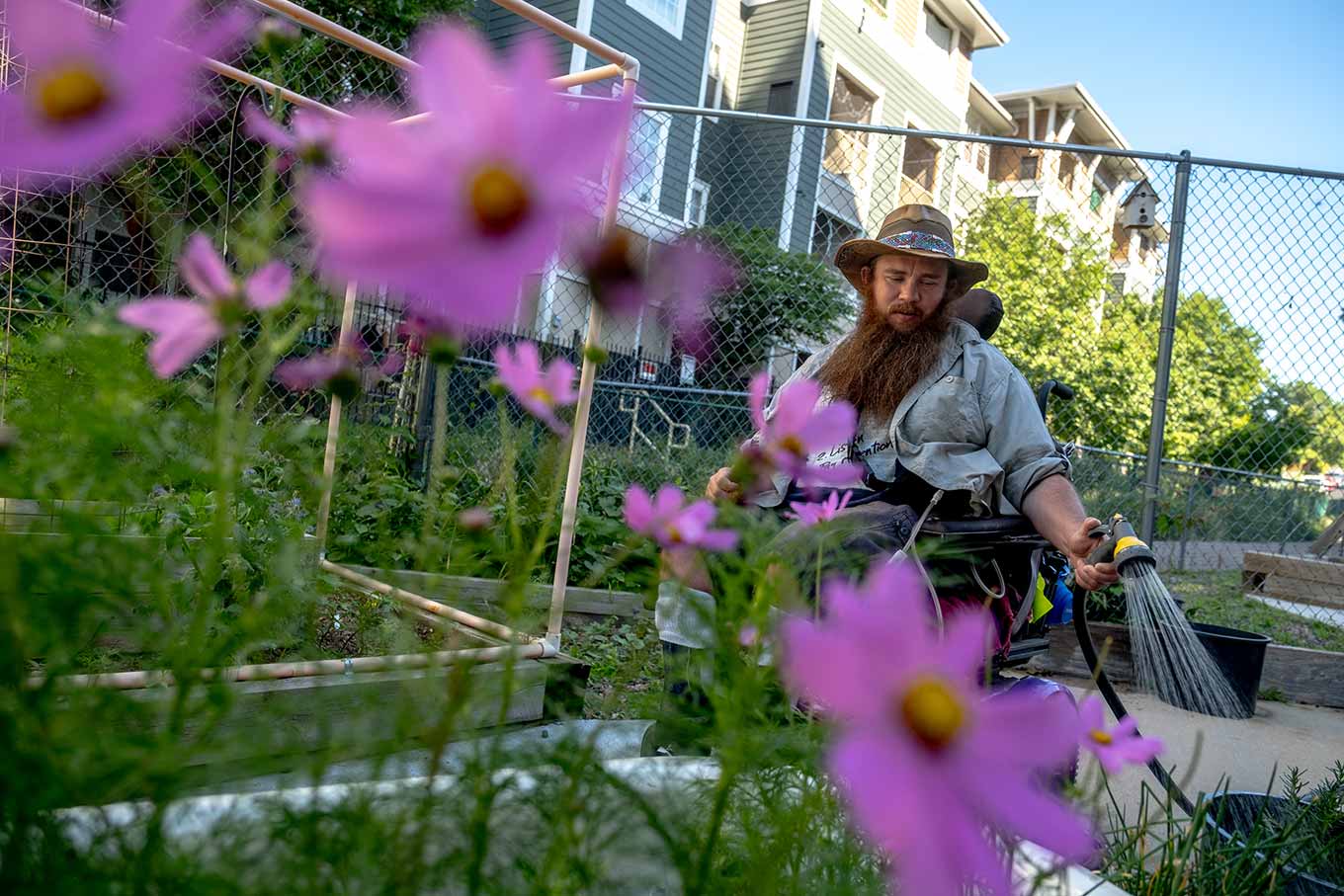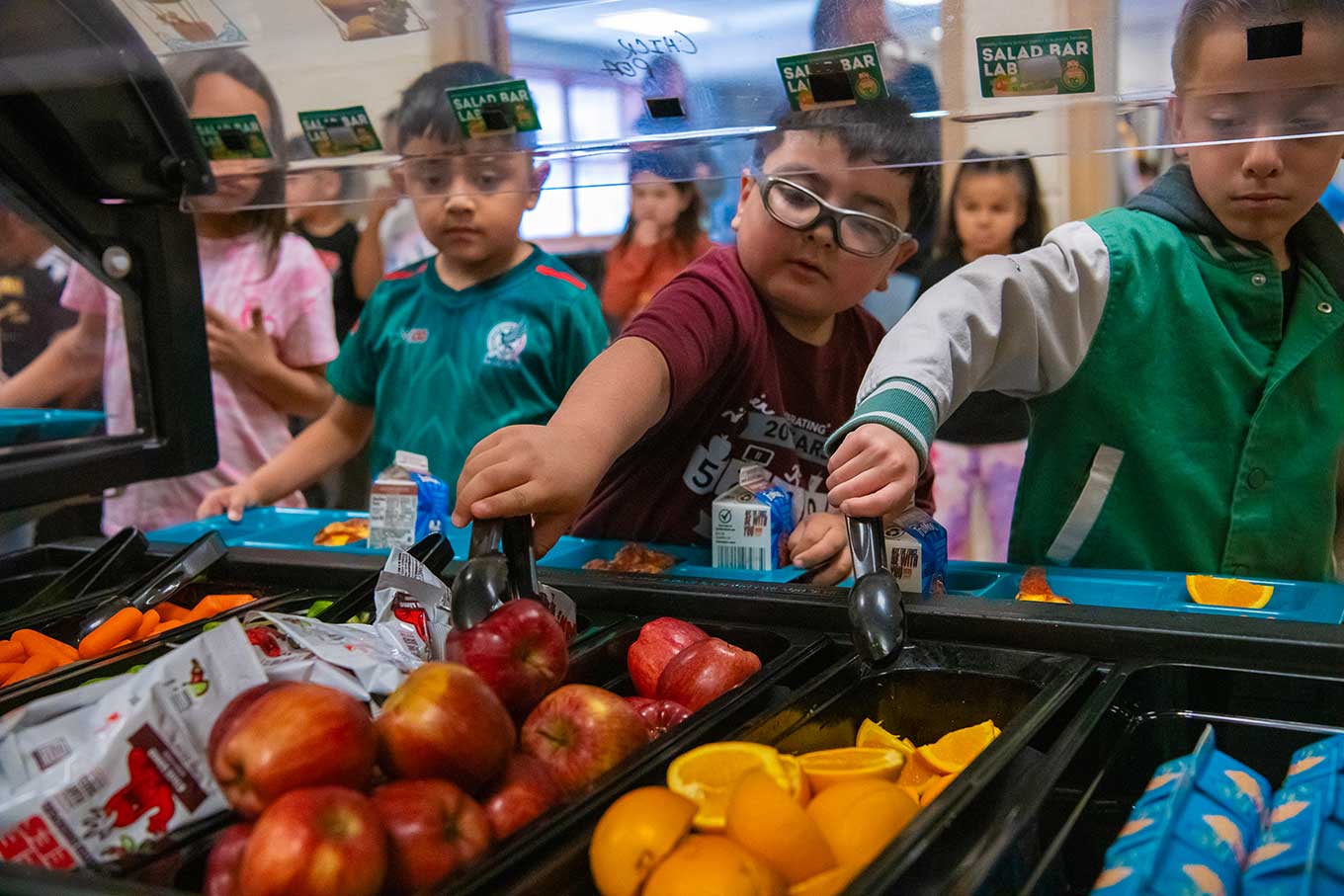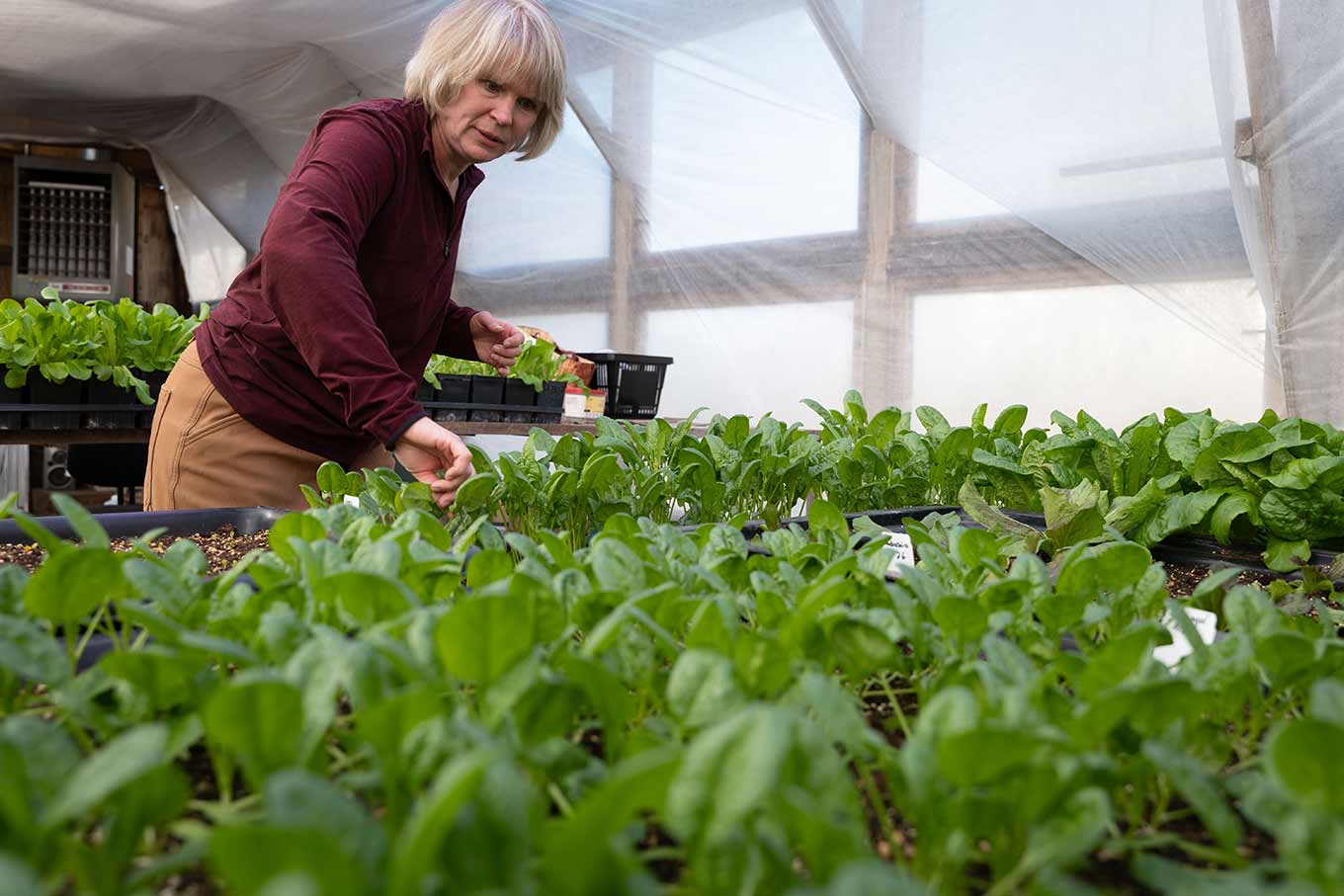“Look at that. Isn’t that beautiful? That’s last year’s carrot.”
James West was pointing at a clump of lacy white flowers poking up in a jumble of blossoms and vegetables. He continued talking, as he is known to do, by telling a story he heard many decades ago in school about the relationship of carrots to Queen Anne’s lace. Both produce similar flowers, but Queen Anne’s lace has a tiny red bud in the center.
“That bud was plucked by servants who used it to dye the clothes for Queen Anne,” West explained.
West, 66, can tell stories galore about horticulture and plant history. He can also toss out a string of Latin names for many of the plants growing in the garden at St. Benedict’s Place in downtown Grand Junction, which houses people who have been homeless for at least three years. And he can grow the heck out of all sorts of vegetables and flowers.
West has been tending the garden at St. Benedict’s Place for the past five years after a lifetime of intermittent homelessness and stints in rehab facilities and jails. He has lived at St. Benedict’s Place since 2013.
The garden is not just for oohing and aahing over giant sunflowers, plumes of bright purple amaranth, unusually prolific broccoli and Swiss chard leaves the size of turkey platters. This garden, on property belonging to the Catholic Diocese of Pueblo, has provided fresh produce for nearly 16 years to the St. Benedict’s Place residents living in one of its 22 units, along with older adults and other community members in need.
Some St. Benedict’s Place residents have moved on, and others have passed on, but the garden continues to bloom.
“The whole idea behind it is to be able to give freely but not to take with abandon,” explained St. Benedict’s Place resident Suzanne, who asked that her last name not be used.
Suzanne can be found several times a week filling a wheelbarrow with weeds. Weeding is her specialty, she said, and her contribution to a space that she said brings her “peace and tranquility”—as well as an abundance of eggplant that she enjoys pickling.
Grand Valley Catholic Outreach built the St. Benedict’s Place housing complex in 2008. One of its earliest residents suggested adding the garden. Rich Nye had a terminal illness when he got tired of sitting in his easy chair and looking out his front window at an empty rock-strewn eyesore of a lot across the street.
Nye didn’t just daydream about seeing a lush garden. According to one of Catholic Outreach’s annual reports, with the help of a priest, a borrowed tractor, some donated seeds and plants, and a few knowledgeable gardeners, Nye had the lot blooming and budding before he died in 2013.
A manager at the housing complex kept the garden going for years after Nye died. During that time, residents, including West, could have plots within the garden to plant their favorite vegetables.
Five years ago, West expanded the garden to about three times its former size. It now fills an entire city lot. He added unusual varieties of vegetables and flowers. He amended formerly graveled areas with compost, grass clippings and mulched leaves so the garden could yield two-pound tomatoes and baseball-sized zinnias.
In addition to providing fresh produce for St. Benedict’s Place residents, the garden’s bounty goes to the soup kitchen at the nearby Grand Valley Catholic Outreach facility, where up to 200 clients eat lunch daily.
At lunch one day in late August, sliced cucumbers and tomatoes from the garden were nestled between fruit salad and a steak stew on trays. Volunteer Kong Vong said patrons enjoy having fresh vegetables along with the starches and proteins in every meal. They also receive fresh produce from the garden in giveaway grocery boxes.
The kitchen features a favorite item from the garden. Folks call the large tomatoes with red-lined yellow skins “Mr. Stripeys.”
The garden at St. Benedict’s Place also yields bounties of cherry tomatoes and the occasional overabundance of zucchini that West carries over to Meals on Wheels Mesa County patrons. West also sometimes places bags of produce on the front porch of the next-door home for priests who serve St. Joseph’s Parish. One of them blesses the garden in a formal ceremony each summer.
Seeds and potted plants from the garden go to the nearby Mesa County Library for a seed exchange and giveaway program and a plant sale fundraiser. Produce is regularly spread out in front of West’s apartment, where St. Benedict’s Place residents can take what they need. The garden has no fence, so people traveling through the neighborhood can pluck some fresh vegetables. A hand-painted sign advises them to “ask before picking,” a reminder that West said is not always followed.
Even though the garden helps feed those in need in various ways, Catholic Outreach does not track output in pounds and dozens or dollars and cents, according to Angela Walsh, the soup kitchen manager. Walsh monitors the garden’s well-being—and what might be coming to her kitchen—by looking through photographs of the garden that West sends her.
The output is not as important as the benefits of the garden, which can’t be measured or eaten, said Carla Bistodeau, the housing director for Catholic Outreach.
“It’s just so cathartic for our people to come over here,” she said. “It’s really everybody’s happy place.”
A resident of another Catholic Outreach housing complex for previously homeless veterans makes salsa from the small plot of tomatoes and peppers he tends in the garden. Downtown workers, including a few regulars from the nearby U.S. Post Office, sometimes wander through the garden on their lunch breaks and pop a cherry tomato in their mouths. Sister Karen Bland, the director of Catholic Outreach, said she likes to take the path through the garden and see the lush greenery in a space that was once the home of the old Catholic Outreach building before it was torn down.
West said if it weren’t for the garden, he would likely be a sedentary, chronically ill person with nothing to give back to an organization and a community that has helped him.
He suffers from arthritis and sciatica, and calcium spurs in his hands and feet. He has an ever-present nasal cannula hooked to an oxygen tank—a result of smoking for 40 years. He carries his oxygen supply in a large rucksack on his back, which adds to his Santa Claus image—a 6-foot, 3-inch man with a big white beard, a well-fed belly, wire glasses and curly white hair.
Throughout his adult life, West worked intermittently at landscaping jobs, where he honed his interest in horticulture. That interest was inherent to growing up on a farm in the Midwest.
Food for the soul is the way West looks at it all. For him, it’s a reason to get up and go out in the world. Some people at Catholic Outreach refer to him as a master gardener, but “I am just a garden master,” he said. He also credits a higher power: “God likes this garden.”
West loves giving garden tours. “Here we have the yellow beans,” he pointed out. “We don’t like green beans.” “That’s a concord grape vine over there.” “This is a Siberian iris.” “There’s a fig tree, goji berries and an elderberry bush.” “See that. It’s bush cherries, and those are gooseberries.” “I tried to start a kiwi tree there, but it died.”

James West, a resident of St. Benedict’s Place, poses for a photo on Tuesday, Sept. 24, 2024, at the complex’s garden where he volunteers in Grand Junction, Colo. Photo by Barton Glasser / Special to The Colorado Trust
The tour continued in his cramped apartment that overlooks the garden. It has been overtaken by plastic bins and cardboard boxes of seeds stacked next to his medications. He has already sorted one stuffed box of seeds that he identifies as next season’s garden. He also has fluttery green plant starts under a grow light on a coffee table.
Suzanne has been canning pesto using the garden’s basil in her nearby apartment. The roof over her head, the peace of a garden, and an abundance of food have removed the fear she had when she was homeless.
“I can’t tell you how frightening it was,” she said of that time.
West says the garden provides a profound lesson in taking the world as it comes at you. Things are constantly changing among the vines and shoots and clumps of greenery. One year, the Mr. Stripeys might be the size of softballs; another, they may not grow at all. This year, the sweet potato patch is thriving. In other years, it has been paltry.
The one thing that doesn’t change is the feeling it conveys. For residents like West, it’s a place with roots and purpose. And, he likes to point out, it provides a haven for a needy feral cat, a busy crowd of bumblebees and a platoon of grateful hummingbirds.
West waves his hands over it all and points this way and that. “There are miracles all over the place,” he said.





